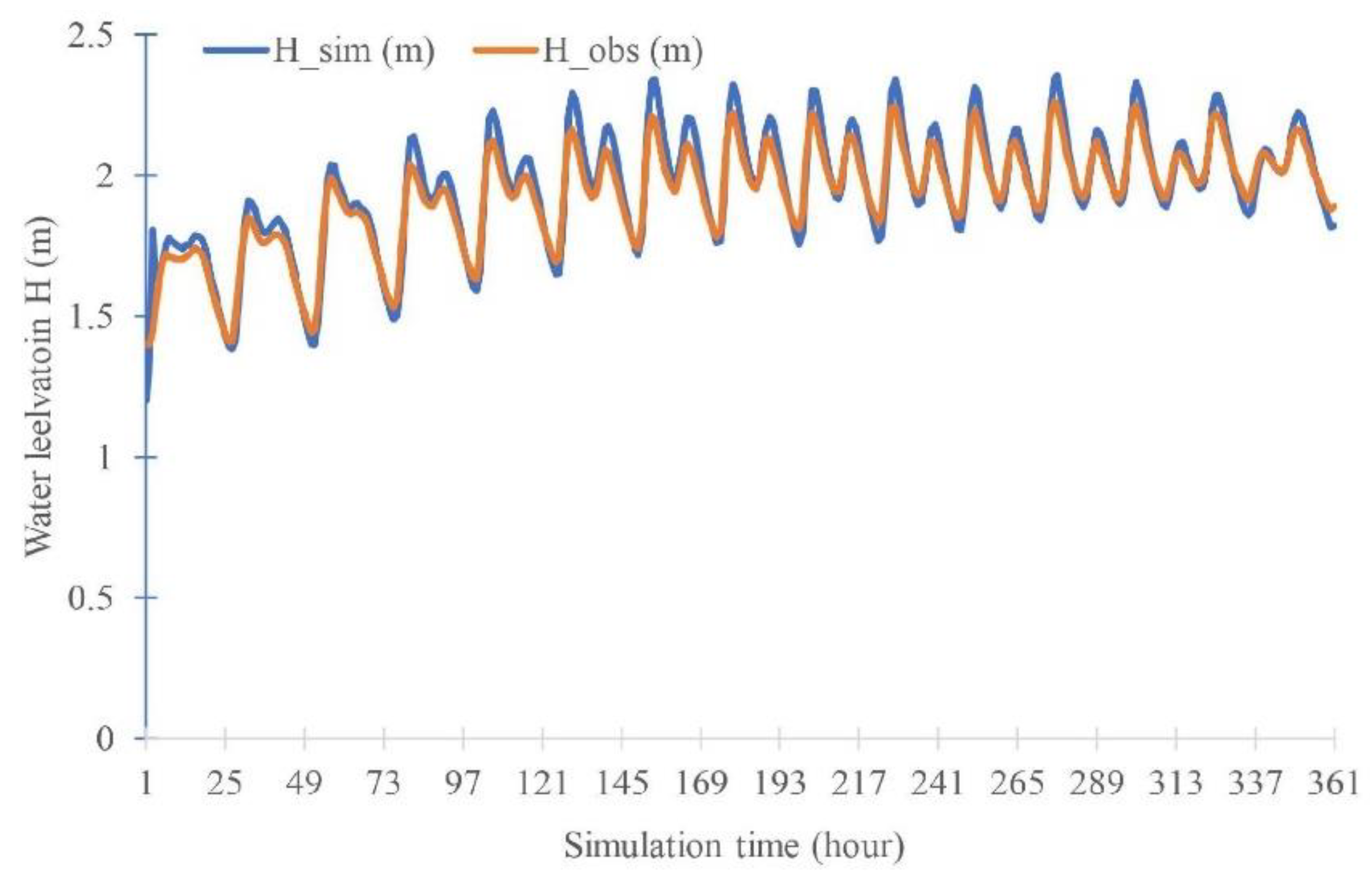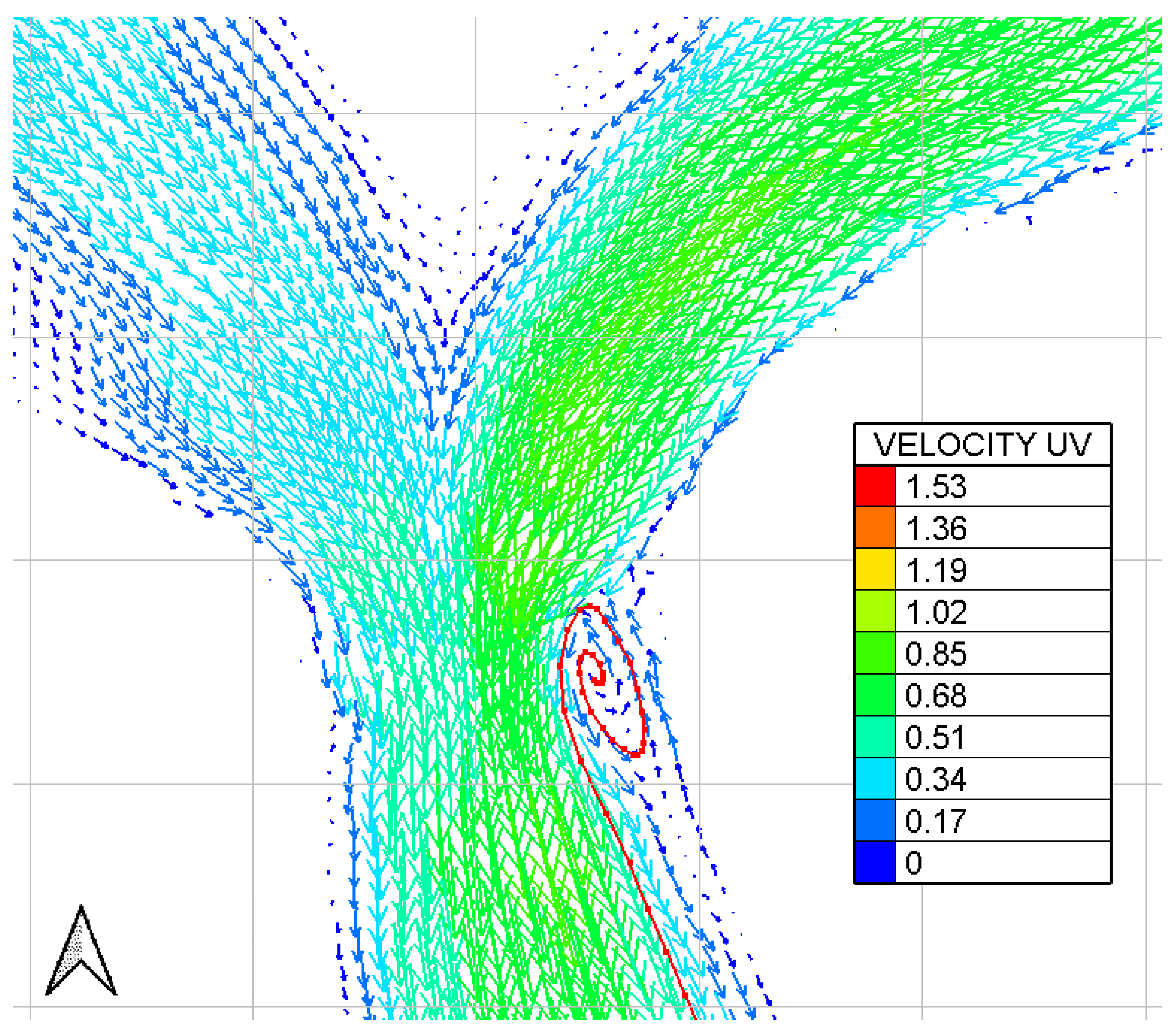Identifying Flow Eddy Currents in the River System as the Riverbank Scouring Cause: A Case Study of the Mekong River
Abstract
:1. Introduction
2. Materials and Methods
2.1. Study Site Selection
2.2. Mesh Generation
2.3. Saint–Venant Equations
2.4. Navier–Stokes Equations
2.5. Model Assessment
2.6. Equipment and Tools
3. Results
3.1. Model Calibration and Assessment
3.2. Eddy Currents
3.3. Discussion
4. Conclusions
Author Contributions
Funding
Institutional Review Board Statement
Informed Consent Statement
Data Availability Statement
Acknowledgments
Conflicts of Interest
References
- Das, T.K.; Haldar, S.K.; DAS Gupta, I.; Sen, S. River Bank Erosion Induced Human Displacement and Its Consequences. Living Rev. Landsc. Res. 2014, 8, 1–35. [Google Scholar] [CrossRef]
- Izumi, N.; Parker, G. Linear stability analysis of channel inception: Downstream-driven theory. J. Fluid Mech. 2000, 419, 239–262. [Google Scholar] [CrossRef]
- Roth, G.; Siccardi, F.; Rosso, R. Hydrodynamic description of the erosional development of drainage patterns. Water Resour. Res. 1989, 25, 319–332. [Google Scholar] [CrossRef]
- Cao, Z.; Pender, G.; Wallis, S.G.; Carling, P. Computational Dam-Break Hydraulics over Erodible Sediment Bed. J. Hydraul. Eng. 2004, 130, 689–703. [Google Scholar] [CrossRef]
- Simpson, G.; Castelltort, S. Coupled model of surface water flow, sediment transport and morphological evolution. Comput. Geosci. 2006, 32, 1600–1614. [Google Scholar] [CrossRef]
- Alaghmand, S.; Abdullah, R.B.; Abustan, I.; Eslamian, S. Comparison between capabilities of HEC-RAS and MIKE11 hydraulic models in river flood risk modelling (a case study of Sungai Kayu Ara River basin, Malaysia). Int. J. Hydrol. Sci. Technol. 2012, 2, 270–291. [Google Scholar] [CrossRef]
- Kadam, P.; Sen, D. Flood inundation simulation in Ajoy River using MIKE-FLOOD. ISH J. Hydraul. Eng. 2012, 18, 129–141. [Google Scholar] [CrossRef]
- Makungo, R.; Odiyo, J.; Ndiritu, J.; Mwaka, B. Rainfall-runoff modelling approach for ungauged catchments: A case study of Nzhelele River sub-quaternary catchment. Phys. Chem. Earth Parts A/B/C 2010, 35, 596–607. [Google Scholar] [CrossRef]
- Moussoulis, E.; Zacharias, I.; Nikolaidis, N.P. Combined hydrological, rainfall–runoff, hydraulic and sediment transport modeling in Upper Acheloos River catchment. Desalination Water Treat. 2016, 57, 11540–11549. [Google Scholar] [CrossRef]
- Talchabhadel, R.; Shakya, N.M.; Dahal, V.; Eslamian, S. Rainfall runoff modelling for flood forecasting (a case study on west rapti watershed). J. Flood Eng. 2015, 6, 53–61. [Google Scholar]
- Lin, B.; Wicks, J.M.; Falconer, R.A.; Adams, K. Integrating 1D and 2D hydrodynamic models for flood simulation. Proc. Inst. Civ. Eng. Water Manag. 2006, 159, 19–25. [Google Scholar] [CrossRef]
- Baban, S.M.; Foster, I.D. Modelling water flow and quality: An evaluation of the ISIS model in the River Avon, United Kingdom. West Indian J. Eng. 2002, 24, 1–15. [Google Scholar]
- Gross, E.J.; Moglen, G.E. Estimating the Hydrological Influence of Maryland State Dams Using GIS and the HEC-1 Model. J. Hydrol. Eng. 2007, 12, 690–693. [Google Scholar] [CrossRef]
- Hydrologic Engineering Center. Introduction and Application of Kinematic Wave Routing Techniques Using HEC-1. US Army Corps of Engineers. Available online: http://www.hec.usace.army.mil/publications/TrainingDocuments/TD-10.pdf (accessed on 30 June 2021).
- Hervouet, J.M. TELEMAC, a hydroinformatic system. Houille Blanche 1999, 85, 21–28. [Google Scholar] [CrossRef]
- Hervouet, J.M. A high resolution 2-D dam-break model using parallelization. Hydrol. Process. 2000, 14, 2211–2230. [Google Scholar] [CrossRef]
- Warren, L. Scour at Bridges—What’s it All About? Open File Report 93-W0487; Geological Survey (U.S.): Reston, VA, USA, 1993.
- Holton, J.R.; Hakim, G.J. An Introduction to Dynamic Meteorology. Am. J. Phys. 1973, 41, 752–754. [Google Scholar] [CrossRef]
- Charles, C.D.; Ify, L.N.; Levi, C.U. Prediction of Eddy current and scour hole positions along river beds. PENCIL Pub. Phys. Sci. Eng. 2015, 1, 1–10. [Google Scholar]
- Dutta, D.; Alam, J.; Umeda, K.; Hayashi, M.; Hironaka, S. A two-dimensional hydrodynamic model for flood inundation simulation: A case study in the lower Mekong river basin. Hydrol. Process. 2007, 21, 1223–1237. [Google Scholar] [CrossRef]
- Kuenzer, C.; Campbell, I.; Roch, M.; Leinenkugel, P.; Tuan, V.Q.; Dech, S. Understanding the impact of hydropower developments in the context of upstream–downstream relations in the Mekong river basin. Sustain. Sci. 2013, 8, 565–584. [Google Scholar] [CrossRef]
- Fujii, H.; Garsdal, H.; Ward, P.; Ishii, M.; Morishita, K.; Boivin, T. Hydrological roles of the Cambodian floodplain of the Mekong River. Int. J. River Basin Manag. 2003, 1, 253–266. [Google Scholar] [CrossRef]
- Letrung, T.; Li, Q.; Li, Y.; Vukien, T.; Nguyenthai, Q. Morphology Evolution of Cuadai Estuary, Mekong River, Southern Vietnam. J. Hydrol. Eng. 2013, 18, 1122–1132. [Google Scholar] [CrossRef]
- van Tho, N. Coastal erosion, river bank erosion and landslides in the Mekong Delta: Causes, effects and solutions. In Geotecnics for Sustainable Infrastructure Development; Springer: Berlin/Heidelberg, Germany, 2020; pp. 957–962. [Google Scholar]
- Achilleos, G. The Inverse Distance Weighted interpolation method and error propagation mechanism—Creating a DEM from an analogue topographical map. J. Spat. Sci. 2011, 56, 283–304. [Google Scholar] [CrossRef]
- Bartier, P.M.; Keller, C. Multivariate interpolation to incorporate thematic surface data using inverse distance weighting (IDW). Comput. Geosci. 1996, 22, 795–799. [Google Scholar] [CrossRef]
- Ata, R.; Goeury, C.; Hervouet, J.M. TELEMAC Modeling System 2D Hydrodynamics TELEMAC2D Software-User Manual; EDF R&D: Paris, France, 2014; Available online: http://www.opentelemac.org/downloads/MANUALS/TELEMAC-2D/telemac-2d_user_manual_en_v7p0.pdf (accessed on 21 January 2021).
- Meyer-Peter, E.; Müller, R. Formulas for bed-load transport. In IAHSR 2nd Meeting, Stockholm, Appendix 2; IAHR: Madrid, Spain, 1948. [Google Scholar]
- Horritt, M.; Bates, P. Evaluation of 1D and 2D numerical models for predicting river flood inundation. J. Hydrol. 2002, 268, 87–99. [Google Scholar] [CrossRef]
- Fernandes, E.H.; Dyer, K.R.; Niencheski, L.F.H. Calibration and validation of the TELEMAC-2D model to the Patos Lagoon (Brazil). J. Coast. Res. 2001, 470–488. [Google Scholar]
- EDF R &, D. TELEMAC Modeling System: 3D Hydrodynamics TEELMAC3D Software 7.1/Operating Manual; Pham, C.-T., Joly, A., Eds.; EDF R & D: Paris, France, 2016; Available online: http://www.opentelemac.org/downloads/MANUALS/TELEMAC-3D/telemac3d_user_manual_v7p1.pdf (accessed on 20 January 2021).
- Moriasi, D.N.; Arnold, J.G.; van Liew, M.W.; Bingner, R.L.; Harmel, R.D.; Veith, T.L. Model evaluation guidelines for systematic quantification of accuracy in watershed simulations. Trans. ASABE 2007, 50, 885–900. [Google Scholar] [CrossRef]
- Canadian Hydraulics Centre. Blue Kenue Reference Manual; Canadian Hydraulics Centre, National Research Council: Ottawa, ON, Canada, 2011. [Google Scholar]
- QD Team. QGIS Geographic Information System, Open-Source Geospatial Foundation Project; QD Team: Norwich, UK, 2016. [Google Scholar]
- Chivers, I.D.; Sleightholme, J. Introduction to Programming with FORTRAN; Springer: Berlin/Heidelberg, Germany, 2006. [Google Scholar]
- Lutz, M. Learning Python: Powerful Object-Oriented Programming; O’Reilly Media, Inc.: Sebastopol, CA, USA, 2013. [Google Scholar]
- R Core Team. R: A Language and Environment for Statistical Computing; R Foundation for Statistical Computing: Vienna, Austria, 2013. [Google Scholar]
- Tri, D.Q.; Hue, L.T. Modeling and forecasting water flow in Vietnam’s Mekong River. In Proceedings of the Scientific Conference on Meteoro-Hydrology and Oceanography, Hanoi, Vietnam, 27 October 2016. [Google Scholar]
- Huy, P.D.A.; Tu, T.T. Assessing variation of riverbank in Vam Nao. Sci. Technol. Dev. J. 2015.
- Dike, C.C.; Nwaogazie, I.L.; Onochie, O. Eddy current propagation: A case study of the Nun River. PENCIL Publ. Phys. Sci. Eng. 2015, 1, 11–20. [Google Scholar]
- Hubbs, S.A. Changes in Riverbed Hydraulic Conductivity and Specific Capacity at Louisville. Riverbank Filtr. Hydrol. 2006, 60, 199–220. [Google Scholar] [CrossRef]
- Leifer, I. A Synthesis Review of Emissions and Fates for the Coal Oil Point Marine Hydrocarbon Seep Field and California Marine Seepage. Geofluids 2019, 2019, 4724587. [Google Scholar] [CrossRef]
- Sharma, H. River dynamics and Hydraulic Structures: River Dynamics for transitional stage rivers with case study of Sharda River near Lakhimpur or variable flow patterns. EasyChair Preprint 2020, 1–14. [Google Scholar]
- Pavoni, J.L.; Stein, D.E. Environmental Impact of Riverbank Revetment; University of Louisville: Louisville, KY, USA, 1975. [Google Scholar]
- Booth, E. Sediment Response to Construction and Recent Adaptive Management of Glen Canyon Dam, Colorado River, Arizona; American Geophysical Union: Washington, DC, USA, 2017. [Google Scholar]
- Youdeowei, P.O.; Abam, T.K.S. Local engineering practices of erosion control in the coastal areas of the Niger Delta. Environ. Earth Sci. 1997, 31, 231–235. [Google Scholar] [CrossRef]












Publisher’s Note: MDPI stays neutral with regard to jurisdictional claims in published maps and institutional affiliations. |
© 2022 by the authors. Licensee MDPI, Basel, Switzerland. This article is an open access article distributed under the terms and conditions of the Creative Commons Attribution (CC BY) license (https://creativecommons.org/licenses/by/4.0/).
Share and Cite
Nguyen, T.T.N.; Shih, D.-S.; Chua, L.H.; Kieu, H.N.; Ha, L.H.; Nguyen, L.H.; Luu, N.V.; Huynh, T.V.; Duong, L.M.; Ngo, A.T.; et al. Identifying Flow Eddy Currents in the River System as the Riverbank Scouring Cause: A Case Study of the Mekong River. Water 2022, 14, 2418. https://doi.org/10.3390/w14152418
Nguyen TTN, Shih D-S, Chua LH, Kieu HN, Ha LH, Nguyen LH, Luu NV, Huynh TV, Duong LM, Ngo AT, et al. Identifying Flow Eddy Currents in the River System as the Riverbank Scouring Cause: A Case Study of the Mekong River. Water. 2022; 14(15):2418. https://doi.org/10.3390/w14152418
Chicago/Turabian StyleNguyen, Tanh T. N., Dong-Sin Shih, Lloyd HC Chua, Huyen N. Kieu, Linh H. Ha, Linh H. Nguyen, Ninh V. Luu, Thai V. Huynh, Linh M. Duong, An T. Ngo, and et al. 2022. "Identifying Flow Eddy Currents in the River System as the Riverbank Scouring Cause: A Case Study of the Mekong River" Water 14, no. 15: 2418. https://doi.org/10.3390/w14152418
APA StyleNguyen, T. T. N., Shih, D.-S., Chua, L. H., Kieu, H. N., Ha, L. H., Nguyen, L. H., Luu, N. V., Huynh, T. V., Duong, L. M., Ngo, A. T., Nguyen, H. V., & Tran, C. N. (2022). Identifying Flow Eddy Currents in the River System as the Riverbank Scouring Cause: A Case Study of the Mekong River. Water, 14(15), 2418. https://doi.org/10.3390/w14152418






